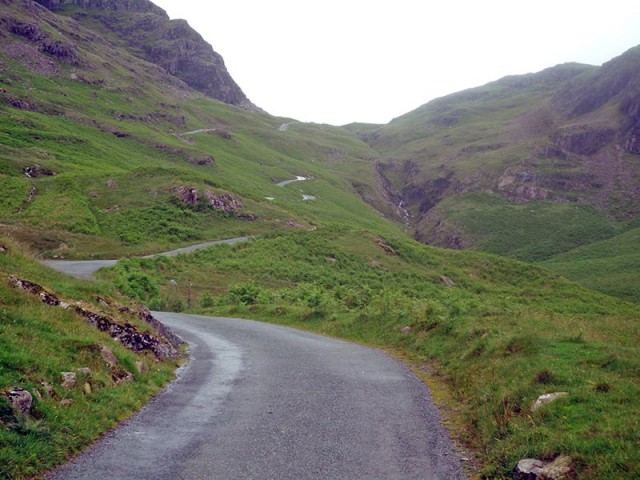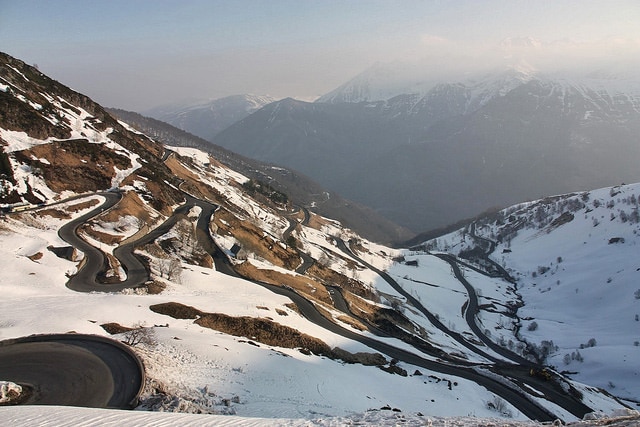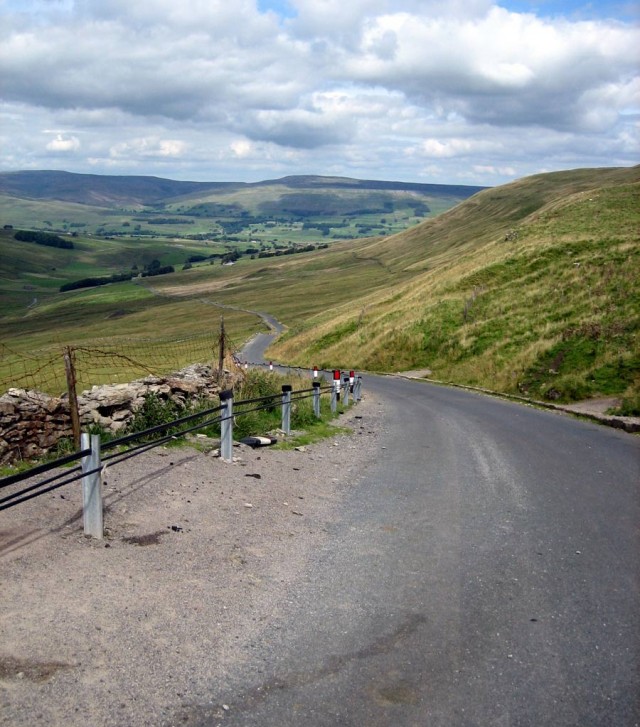The defining feature of British hills is that they are short and steep. Four minutes of a lung bursting effort of gradients up to 30%.

British roads were not built with smooth cycling in mind. We throw a road on the hill and hope for the best; hairpins are a luxury rarely afforded – at best we may get a quarter hairpin so the gradient is kept below 25%. The gradient is never constant, but nearly always variable. You can’t get into a rhythm but will find you are constantly changing gear or wishing you had a lower gear to go into. To add insult to injury, the road surface is invariably rough and potholes create an added challenge.

The Alps and Pyrenees by contrast are wonderfully engineered and manicured climbs. You can have a climb with an average gradient of 8%, but the maximum is 10%. In England, an average of 8%, usually means a maximum of 18-20%. On the continent, the road surfaces are usually something we can only dream of – smooth and well maintained. The other defining thing about the Pyrenees is that the climbs are long 17km, 20km climbs. We just struggle to comprehend how long the hills are. It’s like doing a 10 mile time trial uphill at an average gradient of 9%.
Personal experience
Last year I rode stage 1 of the 2014 Tour de France route over Kidstone pass, Buttertubs, plus a few extra hills like Trapping Hill and Naught Bank Road This involved several climbs of 150m vertical ascent. I rode many of them at quite an intense pace.

At the end of the day I’d done 118 miles and 10,472ft (3,270m) climbing. I was never so exhausted on a bike and grovelled up the last climbs, my legs were really shot away. It took quite a few days to recover.
Riding in the Pyrenees is not quite as damaging to the muscle fibres. Making 100% effort on a one hour climb is very different physiology to making 100% effort on 4 minute steep hill climbs. As mentioned in Luz Ardiden, I was surprised that after 3,700m of climbing the previous day that the legs felt fresher than a short, intense hill climb interval session which might only have 800m of climbing. I did make big efforts on the Tormalet – it is just very different to the short anaerobic climb effort level.
When riding a climb like Fleet Moss (max gradient 20%) you will accumulate more muscle damage by having to use fast twitch fibres and the anaerobic effort levels to get up the steep climbs.
In one sense ‘Alpine style climbs’ are ‘easier’ than British hills. But I’m not trying to diminish the challenge of climbing the Pyrenees; it’s a bit like comparing apples and pears – they are just very different challenges.
Muscle fibres
The other thing to bear in mind is that riders will have different physiologies. I’m a climber by weight, but I also tend to favour long-distance efforts because I have proportionally more slow twitch muscle fibres. I’m used to doing long time trials 50 miles / 100 miles. (BTW: If you want to prepare for riding Alpine style climbs you would probably be better off doing a few 25 / 50 mile time trials than riding up four minute British hill climbs.)
I don’t have explosive speed, but I can maintain a high threshold for longer. In Britain, I always do better – the longer the hill. The Stang at 8 minutes is primarily an aerobic climb – it’s a very different test to a 3 minute climb. I always joked my perfect race would be a 100 mile hill climb. The Pyrenees is as close as it gets.
Hilly classics
If you see who does well in hilly classics like Tour of Flanders, Amstel Gold, Flèche Wallone – it is usually not the Grand Tour hill climb specialists, but riders who are often a little heavier but with more explosive speed for 3-4 minute climbs. On the Tormalet, this explosive speed becomes mostly irrelevant, it is all power to weight ratio – and those riders who can maintain high power to weight for a long-time. It is on these climbs that the real mountain goats come to the fore and very good short-distance climbers drop away. This is what makes cycling so interesting. Variations in terrain change the route to favour different kinds of riders.
If you climb the Tormalet – 1,400m of climbing you can do all the climb seated down, getting into a good rhythm. You can treat it as a hard threshold ride; it is the limit of your aerobic capacity. But, you don’t have to place immediate stress on your muscles by turning over a big gear and going into the very deep anaerobic levels of effort, where you create acidosis and accumulate muscle fatigue very quickly.
If you do 1,400m of climbing in the Yorkshire Dales, it may be equivalent to say riding Fleet Moss six times. There is no question that riding Fleet Moss six times is much more difficult than riding the Tormalet once. But, the thing is, who climbs Fleet Moss six times in succession? With the Pyrenees – once you start at the bottom of the Tormalet, you’re committed to 1,400m of climbing. If you go down the other side, the only way to get home is to do another 1,400m. That’s 2,800m and you’ve only done two climbs!
In a way, it’s a salutary lesson that if you want to be riding all day in the Yorkshire Dales, you should seriously consider a compact chain set and a full range of gears so you can avoid those 50 rpm cadence efforts which will tire you out much more quickly.
Also, like any type of cycling, it depends how you approach them. If you race up steep 20% climbs, I suppose you get the suffering you deserve. But, sometimes with really steep hills, there’s no choice but to really make a big effort.
Metres add up.
The other thing about riding in the Pyrenees is how easy it is for the vertical ascent to add up. The route I took involved 3,700m of climbing in 80 miles (130km). It would be hard to do that level of climbing in Britain, unless you really chose an awkward route.
The joy of continuous climbing.
Riding hills in Britain is invariably a stop start affair. A big effort, brief descent then you start again. Really big hills make take 10-15 minutes. But, often they are just 3-10 minutes. Once you’ve started a mountain pass, you know you can settle down in the saddle for an hour and worry about nothing else other than climbing. This is really what makes the Pyrenees/Alpes so special. You can absorb yourself in climbing, going uphill. It is just far beyond the experience of short climbs. Going up and down a 150m hill several times just cannot replicate the feeling of climbing in the Pyrenees.
I’ve just come back from the Pyrenees and am still in wide-eyed wonder at how good it was. I knew I would enjoy the Pyrenees, but it still exceeded my expectations. If I came back from riding in the Lake District, I would probably have the afterglow of riding up Hardknott Pass.
Both have their respective joys, challenges and difficulties. It is perhaps meaningless to compare. But, if you struggle to do 3,000m of climbing in the Yorkshire Dales, you may well be able to do 3,000m of climbing in the Pyrenees.
Related


“On the continent, the road surfaces are usually something we can only dream of – smooth and well maintained.”
If you share the view that only British roads have holes in them, then I recommend https://www.youtube.com/watch?v=bzAwjqnt9QE. I live in the area (north Germany, the bit below Denmark) and have driven over the road, so I can testify that it really is that bad. The comment to the video is that it was taken in 2013 and since then things have got worse. It is one of the worst examples in the area but not the only one.
The damage is done in spring with cold nights and warmer days that break up the road surface. The reason they stay that way is not enough money to repair them. Councils in Germany are cash-strapped too.
Yes, France may have been better than continent. But, the French do seem to take pride in their road surfaces – at least those which host the Tour de France.
Agree, bucks county road repairs seem to involve throwing some Tarmac into a pot hole and then presumably using a spoon to flatten it. The road crews should be taken to France and join a road maintain acne team to see how they do it.
majorcan roads are very good, much like the french, but I think they understand cyclotourism and that pro races occur on their roads, we let a road get repeatedly patched up before it gets a new black top and then it is great, whilst I don’t cycle on the a34 or the m42 in places they are a mess, lack of investment equals poor roads equals injuries equals cost to nhs that could have been avoided
I can only agree with all of the above. I was lucky enough to win a trip to the Pyrenees this June and thoroughly enjoyed it, particular highlights being the Col de Mente, the 31 hairpins of Luz Ardiden and the Tourmalet (slightly slower than you but I only lost a minute…in the last kilometre :D).
Since getting back I’ve unleashed the post Pyrenean legs on Toys Hill (probably the most challenging of my local climbs) and found the under 9 minute experience to be somewhat more painful than I can remember the hour and a half up the Tourmalet being! Maybe I should’ve gone harder or perhaps the memory has faded quickly and I’d feel differently if was 10km into the climb right now but a longer slow burner certainly seemed easier to manage let alone the up and down repeat cycle you get here on a longer ride.
My local training ride around West Yorkshire takes in almost 5000m of climbs in 100km – around SEVEN Alp d’Huezs, except with gradients of 30%, plus cobbled sections.
Alpine climbs are are wimps. Turbo sessions, with nice scenery.